| |
|
|
|
|
|
|
|
|
 |
| |
|
The papaya tree has a straight trunk that grows up to 8 m high. It does not branch. At the base, the trunk is about 30-40 cm thick. Latex flows from all parts of the tree when it is cut or injured. The leaves grow from the top part of the stem in a spiral. They have long, horizontal stalks measuring 35-105 cm long. The leaves are large, and divided into 5-9 irregular segments. They have prominent yellow ribs and veins. The papaya plant may produce female, male or hermaphrodite (perfect) flowers. The fragrant flowers are fleshy and waxy with five petals . The tree may produce flowers of different sexes depending on environmental conditions or stress.
The papaya fruit range from oval to round, measuring 15-50 cm long and 10-20 cm wide. The largest may weigh up to 9 kg. Unripe fruit are green and hard with white latex. Ripe fruit have light to deep yellow skins with yellow, orange, salmon or red succulent flesh. The flesh is juicy, sweet with an aromatic to musky flavour. The seeds, found in the centre of the fruit, are usually black and surrounded by a transparent, fleshy coating. |
| |
|
Papaya is a short-lived, fast growing, soft wooded perennial . It has an extensive root system, erect growth and does not branch. It can grow up to a height of 8m. The trunk is hollow green or deep-purple 30-40 cm or more thick at the base and roughened by leaf scars. Latex vessels occur in all parts. |
| |
|
The leaves emerge directly from the upper part of the stem in a spiral on nearly horizontal petioles 30-105 cm long. They are hollow, succulent, green or more or less dark purple. The blade, deeply divided into 5 to 9 main segments, each irregularly subdivided, varies from 30-60 cm in width and has prominent yellowish ribs and veins. The life of a leaf is 4 to 6 months. Both the stem and leaves contain copious white milky latex. |
| |
|
The five-petalled flowers are fleshy, waxy and slightly fragrant. Some plants bear only short-stalked female flowers, or hermaphrodite (perfect) flowers also on short stalks, while others may bear only male flowers, clustered on panicles 5 or 6 feet (1.52 or
1.83 meters) long. Some plants may have both male and female flowers. Others in certain seasons produce short-stalked male flowers and at other times perfect flowers. This change of sex may occur temporarily during high temperatures. Male or bisexual plants may change completely to female plants after being beheaded.
How pollination takes place in papayas is not known with certainty. Wind is probably the main agent, as the pollen is light and abundant, but thrips and moths may assist. Hand pollination is sometimes necessary to get a proper fruit set.
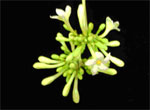 |
|
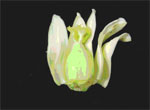 |
Male |
|
Female |
| |
|
|
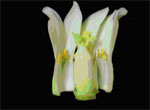 |
|
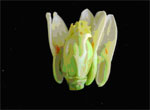 |
Hermaphrodite |
|
Carpelloid |
PLATE 1: PAPAYA FLOWERS
|
| |
|
Generally, the fruit is melon-like, oval to nearly round, or elongated, 15-50 cm long and 10-20 cm thick; weighing over 10 kg. Semi-wild (naturalised) plants bear miniature fruits 2.5-15 cm long. The skin is waxy and thin but fairly tough. When the fruit is green and hard it is rich in white latex. As it ripens, it becomes light or deep-yellow externally and the thick wall of succulent flesh becomes aromatic, yellow, orange or various shades of salmon or red. It is then juicy, sweetish and somewhat like a cantaloupe in flavour; in some types quite musky. Attached lightly to the wall by soft, white, fibrous tissue, are usually numerous small, black, peppery seeds about 5 mm long, each coated with a transparent, gelatinous aril .
The papaya fruit skin has a network of lactifers which in immature fruits contains an abundance of milky, proteolytic latex called papain. The papain is under pressure and spurts out when the skin is pricked. The lactifers collapse as the fruit ripens and there is little or no latex at the fully ripe stage.
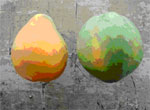
PLATE 2: Sex-linked fruit shape: (L) Pyriform hermaphrodite (R) Round female |
| |
|
Papayas are fast growing plants that require an abundant supply of nutrients if they are to be highly productive. The plants are usually grown from seed, which take 2 to 3 weeks to germinate.
Papaya trees may live up to 25 years or more but productivity declines with age. For fresh fruit production as well as papain production it is best to renew the plantation every 3 years. A high initial growth rate leads to early flowering (within 6 months from sowing) and fruiting (fruit maturing 4-5 months after flowering). The fruit moderates the growth rate, but a steady and relatively fast pace should be maintained to produce fruit throughout the year and in large quantities. |
| |
|
It takes about eight to ten weeks after sowing before seedlings reach a height of 20 cm or 10-12-leaf stage when they are ready for transplanting. After transplanting, shoot growth is initially slow, though considerable root growth is taking place extending out well beyond the canopy line. Stem growth is then rapid up to flowering, increasing in circumference up to 2 mm per day. Growth rate peaks at flowering then declines as the tree starts bearing. The rate of stem growth is influenced by nitrogen and phosphorus supply, irrigation, and temperature. Root growth declines dramatically as flower initiation occurs, continuing at a very low rate during flowering and fruiting.
The cluster of leaves at the apex and along the upper part of the stem makes up the foliage of the tree. New leaves are constantly formed at the apex and old leaves senesce and fall. Usually there are 15 mature leaves per plant. In the tropics, new leaves appear at a rate of two to three a week. The leaf petioles develop at a rapid rate until flowering then increases slowly, and peaking after fruit bearing starts. |
| |
|
New flower buds are formed at leaf axils every two to three days. The time from bud initiation to flower anthesis ranges from 46 to 80 days, the wide discrepancy due to effects of temperature.
Fruit growth shows two major phases. The first phase of rapid growth lasts about 80 days after flower opening, while the second phase is apparent just before fruit maturity. Flesh color is white in immature fruit to a pale orange-yellow, salmon pink, or red depending upon cultivar in ripe fruit. Total fruit starch declines during the first 80 days of fruit development. Sugars begin to accumulate only during the last 28 to 42 days of fruit development. Fruit development usually takes 130 to 160 days from anthesis in the tropics and can be extended to 190 to 270 days in the cooler subtropics. |
| |
|
The papaya is either dioecious with female and male trees or gynodioecious with female and hermaphrodite (bisexual) trees.
Wind is the main agent of pollen dispersal for dioecious varieties with several insect pollinators like honeybees and Skipper butterflies assisting in the role. Dioecious papaya varieties are therefore enforced cross-pollinators because of the separation of male and female flowers on different trees.
In gynodioecious populations with bisexual flowers, the stamens are packed inside the corolla tube and seldom protrude out of the flower. Many gynodioecious varieties such as Sunrise Solo, Kapoho Solo, and Eksotika are self-pollinated. The hermaphrodite flowers are cleistogamous i.e. anthers dehisce and release the pollen to effect self-pollination prior to anthesis of the flower. Such varieties are enforced self-pollinators and seeds gathered from hermaphrodite fruits will usually breed true. |
| |
|
The papaya is a tropical and near-tropical species , limited to the region between 32º north and 32º south of the Equator, with a temperature range of 21-33°C. It needs plenty of rainfall or irrigation but must have good drainage. Plantations should be in sheltered locations or surrounded by windbreaks, as strong winds are detrimental, particularly on soils that cannot make up for large transpiration losses.
Papaya grows best in light, well-drained soils rich in organic matter with soil pH of 6.0-6.5. It can tolerate any kind of soil provided it is well-drained and not too dry. Overly acid soils are corrected by working in lime at the rate of 2.4-4.8 tons/ha. On rich organic soils the papaya grows well and bears heavily but produces fruits of low quality. The roots are very sensitive to water logging. Even short periods of flooding can kill the plants. |
| |
|
| |
Rainfall
Papayas grow well and produce substantial yields without supplementary irrigation if there is a minimum monthly precipitation of approximately 100 mm. Such an ideal distribution rarely occurs as most tropical areas have monsoon-type climates with well-defined wet and dry seasons. Successful production therefore depends upon the availability of supplemental irrigation during the dry period. Drought frequently leads to the rapid shedding of older leaves, reversion of sex to unproductive male and poor fruit set. At the other extreme, flooding frequently leads to plant death due to root rot.
Temperature
Optimum temperature for growth is between 21°C to 33°C. Dioecious cultivars are better suited to low temperatures (<20°C), as female trees do not exhibit the sex changes shown by the more sensitive bisexual (hermaphroditic) cultivars. Hermaphroditic cultivars (Eksotika or Solo types) grown with minimum temperature less than 17°C may have 100% of the flowers reverting to femaleness. At higher temperatures (>35°C), there is a tendency of hermaphrodite cultivars to form functional male flowers with poorly developed and non-functional female parts. This tendency varies with cultivars and within a cultivar.
Radiation
Papaya is a sun-loving plant. When subjected to shade the plant grows tall with increased internode length and etiolated leaves.
Wind
Papaya trees are delicate and require protection from strong winds. The root system is well-developed though relatively shallow and the tree can be uprooted by winds of 64 km hr -1 , especially if the soil is softened by rain. Even though trees withstand uprooting, considerable damage occurs to the large leaves leading to flower and young fruit abscission and low total soluble solids in the more mature fruits. Recovery from wind damage can take from 4 to 8 weeks.
Soil
Papayas are grown in a variety of soil types with the most essential requirement being drainage; poor drainage leads to the development of root rots. A porous loam or sandy loam soil is preferred. Papaya grows well at soil pH between 5.0 and 7.0. At pH levels below 5.0, lime application is necessary to increase growth and yield.
Papaya can be grown successfully even on marginal soils such as peat, and acid sulphate, if the inherent shortcomings of these soils are taken care of. For peat soils, high rates of lime application (6 – 8 tonnes/ha) are essential for cultivation . Micronutrients like boron , zinc and copper should also be applied regularly to ensure production of quality fruits. Since the water table is usually high, the area requires drainage before papaya, which is sensitive to flooding, can be grown. Yields of more than 100 mt/ha for some selected hybrids have been obtained from peat soils. However one major constraint is the tendency for trees to lodge (fall over), especially for heavy bearers, because of poor anchorage. To overcome lodging , trees need to be staked or supported. It is also difficult to mechanize farm operations on the soft peat surface.
With proper management and liming, papaya can also be grown on acid-sulphate soils, which are compact, acidic, contain toxic concentrations of certain micro-nutrients and are prone to flooding. However, papayas cultivated on these soils have a relatively shorter economic life span due to poorly developed root systems and extreme susceptibility to root and collar diseases resulting from poor drainage conditions. Heavy clay soils should preferably be avoided as the compact nature of these soils cause prolonged flooding, which is detrimental to papaya growth. |
| |
|
Though the exact area of its origin is unknown, the papaya is believed to be native to tropical America, probably in southern Mexico and neighboring Central America. Seeds were taken to Panama and then the Dominican Republic before 1525 and cultivation spread to warm elevations throughout South and Central America, southern Mexico, the West Indies and Bahamas, and to Bermuda in 1616. Spaniards carried seeds to the Philippines in about 1550 and the papaya traveled from there to Malaysia and India. Seeds were then sent from India to Naples in 1626. It reached Hawaii in 1800-1820's. The papaya is now familiar in nearly all tropical regions. |
| |
|
| |
|
| |
| |
| |
|
 |
 |
 |
| Names |
| |
|
|
|
Carica papaya |
|
|
Common: |
|
English: |
papaya, pawpaw |
Indonesia: |
papaya, gedang, kates |
Malaysia: |
betek, ketala |
Tagalog (Philippines): |
kapaya, lapaya, papaya |
Thai: |
loko, makuai, malakor, thet |
| Tamil: |
pappali |
Mandarin: |
mugua |
Lao: |
houng |
Vietnam: |
du du |
Cambodian: |
doeum lahong, ihong |
Burmese: |
thimbaw |
|
|
Taxonomic Position: |
| |
|
Domain: |
Eukaryota |
Kingdom: |
Viridiplantae |
Phylum: |
Spermatophyta |
| Subphylum: |
Angiospermae |
Class: |
Dicotyledonae |
Order: |
Violales |
Family: |
Caricaceae |
| |
|
| Other Names Used: |
| |
| Carica peltata Hook. & Arn. |
| Carica posoposa L. |
Papaya carica Gaertn.
|
|
 |
 |
 |
|
| |
| |
|

